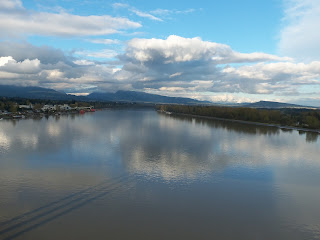Today, Earth Day, is an
appropriate conclusion to this chapter of the Fraser River expedition. As I unpack the information held in these
samples over the coming months, I hope to learn about how this river transmits
the products of photosynthesis and respiration on land to the coastal
ocean. What sort of role does the Fraser
play in global exchanges of carbon between the air, rocks, plants, soil, and
water? How will these processes change
in the future as the Earth warms? For
rivers, which cross the boundaries between land, ocean, and atmosphere,
answering these questions has never been more important. Luckily, working on these problems also
happens to be a lot of fun.
After two weeks of
almost uninterrupted grey weather, even the stubborn locals here started to
stay indoors. Thursday and Friday introduced
me to a new experience: I finished sampling without a visit from a single
rower, canoe team, or wandering dog-walker.
Fort Langley felt deserted, save for the occasional passing freight
train. Then suddenly, the sun returned
and this afternoon the town was abuzz with shoppers, gelato-fueled
children, and everyone else with an acute vitamin D deficiency within a 5-mile
radius. But the sampling dock was still a
peaceful haven with the quiet hum of the river and phenomenal views of the
nearby mountains.
On Saturday, the whole
UFV team came out for one last group sampling session. The skies defied the forecast and spared us
from getting drenched. We celebrated our
luck by posing for a few group photos. My
ultra-high-frequency sampling is drawing to a close, but the students will keep
coming out every week or two. My
early-freshet samples have hopefully captured the rapid pulse of DOC in
exciting detail, and the sampling throughout the summer will characterize the
bulk of the year’s other chemical fluxes.
In the span of only a few short weeks, I’ve watched the water flow of the Fraser increase to about 3x its winter baseline level. Turbidity (or muddiness) has spiked twice, maxing out at over 20 times its initial value. Dissolved organic carbon concentration, according to the fluorescent probe, has approximately tripled. The other more nuanced changes will have to wait for sample analysis to be revealed. I can’t wait to see what these samples have to tell us about how the chemistry of the Fraser River responds to the transition into summer!











